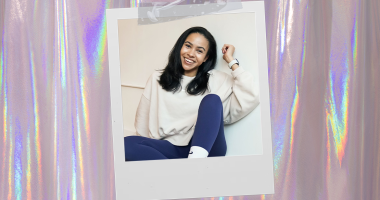Picture this: After drifting off to sleep, you suddenly find yourself in your old high school homeroom. Everything looks as it should, except for some reason, the entire classroom of students is staring at you. You wonder why, until you look down. To your absolute horror, you realize you’ve shown up to school naked. This isn’t just a cursed dream scenario; for those who experience scopophobia—that is, a paralyzing fear of being seen and scrutinized by others—this type of situation haunts their waking life, too.
If you have scopophobia, you might avoid eye contact with other people, or struggle to do anything in public that might involve being seen. People with scopophobia might also struggle with Zoom meetings or online learning (situations in which you’re constantly on display), as shown by this 2023 study published in the journal BMC Medical Education1.
“The reality is, the majority of people are not staring at you. We’re not looking at someone, we’re just looking at them because they’re there.” —Sanam Hafeez, PsyD
Feeling anxious about being seen by others, especially when you feel like you don’t look your best, is totally normal, but when that fear intrudes upon your ability to lead a normal life, it may be time to seek professional help. If you think you might be scopophobic or love someone who struggles with a fear of socializing, there are ways to navigate it. Ahead, clinical psychologists dive deeper into scophobia, explaining what exactly it entails, why it happens, and how to treat it.
In This Article
Experts In This Article
What is scopophobia?
At its core, scopophobia is “a fear of being stared at,” says clinical psychologist Sanam Hafeez, PsyD. In medical terms, scopophobia (also referred to as scoptophobia or ophthalmophobia in medical literature) is an intense fear of being watched or visually scrutinized by others in person.
Scopophobia itself is not a formal mental health diagnosis. But it is a type of specific phobia, an anxiety disorder where someone has an excessive fear targeted toward specific objects, situations, people, or activities. Specific phobias like scopophobia are more prevalent than you’d think: According to the National Comorbidity Survey Replication (NCS-R), an estimated 12.5 percent of adults in the United States will experience a specific phobia at some time in their lives.
Symptoms of scopophobia
Symptoms of scopophobia will vary from person to person, says Dr. Hafeez. Still, some common psychological symptoms are shared among many people with scopophobia, including:
- An extreme fear of being seen or stared at
- Avoidance of social situations
- Isolation
- Anxiety surrounding upcoming social events
Kevin Chapman, PhD, clinical psychologist and founder of the Kentucky Center for Anxiety and Related Disorders says that people who suffer from scopophobia and other specific phobias also may experience certain physical sensations, like a racing heartbeat, when confronted with the possibility of being seen by others. Other potential physical symptoms may include:
- Sweating
- Trembling or shaking
- Nausea
It’s important to note that experiencing occasional nervousness or discomfort in social situations is *totally* normal, especially when the stakes are high and you’ve been expected to act in a certain manner, like a quarterly business meeting, or a friend’s wedding. But when these feelings extend beyond specific events and they begin to significantly interfere with your daily functions and quality of life, it may be indicative of scopophobia or a separate social anxiety disorder. (More on the differences between those in a bit.) In that case, it’s a good idea to seek help from a licensed professional.
What triggers scopophobia?
For people who struggle with scopophobia, the prospect of being looked at by other people can set off their fear of being seen. The origins of any phobia—thanatophobia, somniphobia, cherophobia, and so on—will vary from case to case. Still, according to Dr. Chapman, all phobias stem from three primary pathways, outlined below.
1. Observational learning
Dr. Chapman says that it’s a common misconception that phobias only stem from trauma. Rather, many phobias can be tied to observational learning, or modeling a behavior we were exposed to in our childhood. “In other words, if I have an anxious parent or caregiver, then modeling distress in the context of an object or situation can be powerful enough for some people who have a propensity to have phobias, to develop one themselves,” says Dr. Chapman.
For sufferers of scopophobia, this could look like a child who observes a parent who is overly concerned about how others perceive them, or a parent that constantly warns their child about the repercussions of acting or looking a certain way in front of others.
2. Trauma or lived experiences
The pathway most of us associate with the formation of phobias is through trauma, or past negative experiences with the thing we’ve developed a phobia of. “A minority of phobias develop through, say, being attacked by a dog, being trapped in an elevator, having too much turbulence, or having a panic attack on a plane,” says Dr. Chapman. And while some phobias are formed this way, it’s not as common as through observational learning.
For scopophobic individuals, a formative lived experience could be performing or presenting something in front of others or being bullied for their appearance or form of personal expression.
3. Information transmission
The third and final pathway occurs when a person hears details about the threat of danger2 from someone else. In regards to scopophobia, this could look like seeing a viral video of someone explaining a negative outcome of themselves being seen in public, reading a story about someone who was bullied for how they acted or looked in public, or being told outright that they should be afraid of being seen in public.
As far as risk factors go, research has shown that, overall, women are more likely to be diagnosed with a specific phobia than men. Dr. Chapman adds that genetics can play a role, too. Research suggests that people who have a family history of phobias are more likely to be diagnosed with one themselves.
Are scopophobia and paranoia the same thing?
Simply put, no. Paranoia is a mental condition3 marked by an irrational and severe fear or distrust of others. Paranoia can manifest as delusions or hallucinations that people are “out to get you”. Unlike scopophobia, it is not a stand-alone diagnosis, but rather a symptom of several different diagnoses including paranoid personality disorder and psychotic disorders such as schizophrenia and delusional disorder.
People with bipolar disorder may also experience paranoia. Paranoia is not included in the DSM-5 criteria for the diagnosis of bipolar disorder. (Meaning, you don’t need to have paranoia to have that diagnosis.) But some people with bipolar disorder can feel paranoid because they’re experiencing psychosis, a common comorbidity of bipolar patients4.
For scopophobic individuals, “paranoia can be a component,” of what they’re dealing with, says Dr. Hafeez. That paranoia may manifest as an irrational suspicion and distrust that people are purposefully staring at them and scrutinized. “The paranoia part of the piece [may be] that they think that they are being singled out for some reason,” she says.
Scopophobia vs. social phobia vs. social anxiety
While scopophobia, social phobia, and social anxiety may seem interchangeable (since they all involve to some degree issues surrounding social interaction), they are indeed three separate diagnoses with three separate criteria.
As mentioned earlier, scopophobia involves the specific fear of being seen or stared at by people. Social anxiety is a different type of anxiety disorder, in which people feel anxiety or fear of being judged in social settings, like speaking in public or talking to strangers at a department store. With social anxiety, a person is often still able to socialize despite their discomfort or nervousness, says Dr. Hafeez. (And the fear or stress they feel is more about being judged by others rather than being perceived by others.)
“Social phobia,” on the other hand, “is an extreme form of social anxiety where the idea of socializing is terrifying,” explains Dr. Hafeez. “People who have social phobia may avoid socializing altogether.” She says that if or when social anxiety becomes “unbearable,” it could then become a social phobia.
Sometimes, people with scopophobia might also have social anxiety or social phobia. But that’s not always the case; these are three different disorders.
This all might seem like the splitting of psychiatric hairs, but the differences matter because they impact treatment. People who struggle with social anxiety likely won’t need the help of exposure therapy (a hallmark of phobia treatment; we’ll get more into that in a minute) since they’re often able to push past their anxieties to be in social situations, says Dr. Hafeez. Rather, people with social anxiety likely would benefit more from implementing other anxiety management methods like breathing techniques, mindfulness, lifestyle changes, and prescription medications.
Treatment of scopophobia
According to Dr. Hafeez and Dr. Chapman, the three best treatment methods for scopophobia that a medical professional can provide include a combination of cognitive behavioral therapy (CBT) to pinpoint the source of the phobia, exposure therapy to gradually expose the patient to the scenario they fear, plus some form of medication to alleviate the patient’s symptoms of anxiety, like selective serotonin reuptake inhibitors (SSRIs).
“The most ideal combination treatment would be [seeing] a psychiatrist who would prescribe an anxiety medication, like an SSRI, and ideally, cognitive behavioral therapy with a very specific component of systematic desensitization, or what we call exposure therapy,” says Dr. Hafeez.
Exposure therapy, says Chapman, is the gold standard for treating phobias of any kind. Just as its name suggests, exposure therapy involves exposing the patient to social situations, like eating out in public, in order to invalidate their fear of being seen or scrutinized by other people. “The key here is developing a new, non-threatening association,” explains Chapman. “The bottom line question that you have to ask yourself is, what does this specific client need to learn? The answer to that question really sets the stage for the parameters of the exact exposure you will do.”
Dr. Hafeez says that through repeated exposure to social situations, scopophobic people begin to learn that their fears aren’t rooted in reality. “The reality is, the majority of people are not staring at you,” says Dr. Hafeez. “We’re not looking at someone, we’re just looking at them because they’re there. We’re not examining them. We’re not dissecting them. We’re just looking at them.”
How do I overcome scopophobia at home?
While enlisting the help of a medical professional is highly encouraged (especially if your fear of socializing has begun to limit or impact your quality of life), there are a few methods that Dr. Hafeez says you can try at home in order to alleviate some of the symptoms of scopophobia.
1. Role-play social situations
If your scopophobia stems from insecurity about how you interact with others in social settings, try acting out social scenarios with someone you trust. “Role-playing social situations can be highly effective,” says Dr. Hafeez. This can be a safe way to reacquaint yourself with common scenarios that happen in public without taking the training wheels off immediately, so to speak. She suggests practicing with a therapist or a loved one.
2. Enlist a loved one to attend social events with you
If you’re especially nervous about being seen alone, a great way to yourself back into social settings is by attending an outing with a loved one, says Dr. Hafeez. Having someone you trust accompany you can give you the extra support you need to brave being out in public. “Taking a friend or a family member with you to a social event can help you ease into it,” she says. Even attending a social event for a 10-15 minute window can be helpful in getting used to being seen in public, she adds.
3. Gradually increase your time spent in public
After breaking the seal of socialization, make an effort to increase the length of time you spend in public. “Aim to increase the amount of time spent in social situations gradually,” says Dr. Hafeez. By slowly adding to the amount of time you spend in public, you’ll gradually become more and more comfortable with the idea of being in public, she says.
Coping with scopophobia
While there isn’t a quick fix for scopophobia (or any phobia, for that matter) it can certainly be treated with professional guidance, says Dr. Chapman. If you notice yourself actively avoiding being in public because you fear people will stare at you, it could indicate that you’re indeed suffering from scopophobia. And if that’s the case, you may need assistance from a clinical psychologist, who can help you re-learn how to navigate social situations in a healthy way.
Remember: If fear is hindering your ability to find joy, engage socially, or maintain your daily routine, seeking help from a mental health professional is essential, says Dr. Chapman. They can support you in disrupting your fear of socializing and help you gradually reintegrate happiness into your life.
Well+Good articles reference scientific, reliable, recent, robust studies to back up the information we share. You can trust us along your wellness journey.
- Alencar, Mateus Sudário et al. “Association of scopophobia with online learning fatigue among medical students in Brazil.” BMC medical education vol. 23,1 221. 6 Apr. 2023, doi:10.1186/s12909-023-04199-z
- Muris, Peter, and Andy P Field. “The role of verbal threat information in the development of childhood fear. “Beware the Jabberwock!”.” Clinical child and family psychology review vol. 13,2 (2010): 129-50. doi:10.1007/s10567-010-0064-1
- Birkeland, Søren F. “Paranoia” [Paranoia]. Ugeskrift for laeger vol. 169,42 (2007): 3566-70.
- Chakrabarti, Subho, and Navdeep Singh. “Psychotic symptoms in bipolar disorder and their impact on the illness: A systematic review.” World journal of psychiatry vol. 12,9 1204-1232. 19 Sep. 2022, doi:10.5498/wjp.v12.i9.1204
Source: Well and Good









